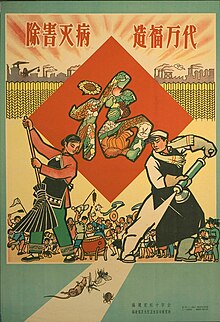
Back استئصال الأمراض المعدية Arabic Erradicació de malalties infeccioses Catalan Eradikace Czech Eradikation German Eradication of infectious diseases English Erradicación de enfermedades infecciosas Spanish ریشهکنی بیماریهای عفونی Persian ביעור מחלה HE Pemberantasan penyakit menular ID Халдварт өвчнийг устгах нь Mongolian
This article needs to be updated. (December 2023) |


Eradication is the lowering of an infectious disease's numbers in all those suffering from it in the world's population to zero.[1] It is sometimes confused with elimination of infectious diseases. That is the lowering of an infectious disease's numbers in all those suffering from it in a local population to zero. The only human disease to be eradicated is smallpox. The only animal disease eradicated is rinderpest.[2] Vaccination was vitally important to the eradication of smallpox[3] and rinderpest.[3][4] Vaccination is vitally important to current polio eradication efforts.[3] Vaccination is vitally important to current measles eradication efforts.[3]
The World Organisation for Animal Health thinks the animal diseases which could be soonest eradicated are African swine fever, Bovine tuberculosis, Foot and mouth disease and Peste des petits ruminants (PPR, ovine rinderpest).[5] A disease which is easier to eradicate is more eradicable. A disease which is easier to eradicate has a higher eradicability.
Former President of the United States of America Carter wants to make Guinea Worm the 2nd eradicated human disease.[6] The Carter Center's International Task Force for Disease Eradication works to achieve this goal.[6]
The Covid pandemic slowed many eradication efforts.[7]
Eradication requires many resources. For this reason it is hard to decide whether to eradicate a disease or not. When deciding people consider: Does the disease have a secondary host? (A secondary host will still have the disease if the disease is eradicated in humans.) Can we clearly identify who has the disease? Does an accurate diagnostic exist? Is there enough money? Is there enough political support?
It is possible that eradication of human disease is only possible if humans are the only host.[8]
- ↑ Dowdle WR (1998). "The principles of disease elimination and eradication". Bulletin of the World Health Organization. 76 Suppl 2 (S2): 22–5. PMC 2305684. PMID 10063669.
- ↑ Year: 2022 Rinderpest and its eradication. WILLIAM TAYLOR, E. PAUL J. GIBBS, SANTANU K. BANDYOPADHYAY, PAUL-PIERRE PASTORET & PROTUS ATANG (Editors) ISBN: 978-92-5-136090-3 978-92-95115-60-6 http://www.fao.org/family-farming/detail/en/c/1616097/ Page xii.
- ↑ 3.0 3.1 3.2 3.3 2014. Review article. Volume 369. royalsocietypublishing
.org /doi /10 .1098 /rstb .2013 .0433. - ↑ Year: 2022 Rinderpest and its eradication. WILLIAM TAYLOR, E. PAUL J. GIBBS, SANTANU K. BANDYOPADHYAY, PAUL-PIERRE PASTORET & PROTUS ATANG (Editors) ISBN: 978-92-5-136090-3 978-92-95115-60-6 http://www.fao.org/family-farming/detail/en/c/1616097/ Pages xii, ix.
- ↑ "Disease Eradication". 2023.
- ↑ 6.0 6.1 Cite error: The named reference
Without drug or vaccinewas used but no text was provided for refs named (see the help page). - ↑ International Task Force for Disease Eradication (ITFDE) (2023). "Summary of the Thirty-Fifth Meeting of the International Task Force for Disease Eradication (ITFDE)" (PDF).
- ↑ Cite error: The named reference
Eliminate COVID-19was used but no text was provided for refs named (see the help page).